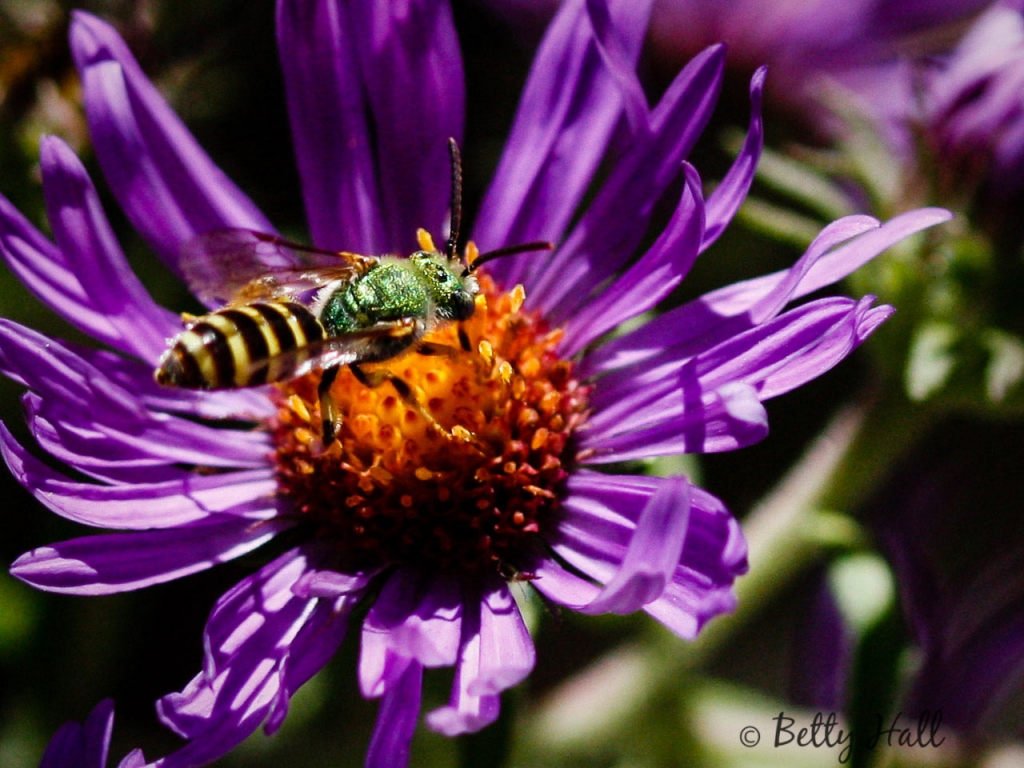

You can read more about the Halictidae family at the University of Florida IFAS Feature Creatures website. Many bees in this family nest in the ground. Green metallic bees are members of the Halictidae family commonly called sweat bees for the behavior of some of the species of being attracted to perspiration. The 2 pairs of wings are dark, not clear. Males guard hairy plants such as lamb’s-ear, fighting off other bees to ensure they get to mate with visiting females. The tripartite sweat bee (Halictus tripartitus) is a member of a family known as sweat bees due to their. Description: Female wool carder bees gather balls of plant hairs to build their nest cells. Tripartite sweat bee (Halictus tripartitus). splendens female has a metallic blue-green abdomen with dark bands and the male has a yellow and black banded abdomen. Nesting habits: Aerial nester including bee hotels. These bees generally do not sting, unless you happen to accidentally squash them or press them against your skin.A small bee that can be seen in much of the eastern US from April through October, possibly year-round in Florida.Īll of the species of Agapostemon are at least partially metallic green. Roulston) bumble bee (Charles Schurch Lewallen) Most bees forage and feed by day but crepuscular bees can see in dim light at dusk and dawn. Naturally, during summers, these bees tend to become a nuisance since they love human sweat. Reproduced with permission from: Nancy Bresich, PhD and Albert Greene. Hover flies go by several other names, including corn. While both may evoke alarm in people, they are vital to our environment as they make fantastic pollinators. The main differences between a hover fly and a sweat bee include their appearance, number of wings, diet, sting, and behavior. Their tiny size ensures that we humans barely notice or register when they alight on our skin. A to Z Guides Reference What to Know About Sweat Bees Written by Alyssa Anderson Medically Reviewed by Poonam Sachdev on JanuWhat Is a Sweat Bee Physical Characteristics of. The 5 Key Differences Between a Hoverfly and a Sweat Bee. They are named ‘sweat’ bees because they are attracted to the salt present in human perspiration.

They are even known to visit window or terrace gardens 30-stories high! Why the Name ‘Sweat Bees’? They are known to nest in the ground or occupy cracks in the soil or sidewalks. These sweat bee species have flight patterns similar to honey bees and bumble bees. Their relatively small size, between 4 mm to 10 mm, make them rather inconspicuous. Striped green sweat bees are found in temperate regions in North and South America.

A rather discernible feature of these bees are their long hairy legs, which are extremely useful in the vital process of pollination. These bees are fairly common across the world, except Australia, and vary in color from red to yellow to green to metallic colors. Currently, about 49 species of sweat bees have been identified. Sweat bees is the name given to a large number of species of bees belonging to the family Halictidae, of the order Hymenoptera. Types Of Sweat Bees There are many species, with approximately 4300 subspecies in the Halictidae family worldwide, but different regions will have different subspecies of sweat bees.

So let’s go over some of the different species and talk about these less-familiar bee types. Getting stung by a ground bee is really uncommonunlike other insects, ground bees tend to avoid conflict rather than sting. Can sweat bees sting Female sweat bees sometimes sting people, but it doesn’t hurt all that much. And although nocturnal insects are often equipped with superposition eyes, which greatly enhance light capture, Megalopta performs visually guided flight with apposition eyes. What does a sweat bee look like In short, it varies. Dan Greenwood Last Updated: JWhat Do Sweat Bees Look Like The sweat bee is a relatively common bee, but it often goes unnoticed until it lands on a sweaty arm. 2 Sweat bees like to eat the sweat on your skin, but they don’t hurt you by doing this. Sweat bees are known to be kleptoparasites, because they feed on the eggs of other bees, and lay their own eggs in the owner bees’ nest. The sweat bee Megalopta (Hymenoptera: Halictidae), unlike most bees, flies in extremely dim light. Buy the royalty-free Stock image Sweat Bee on Yellow Flower online All image rights included High resolution picture for print, web & Social Media.


 0 kommentar(er)
0 kommentar(er)
